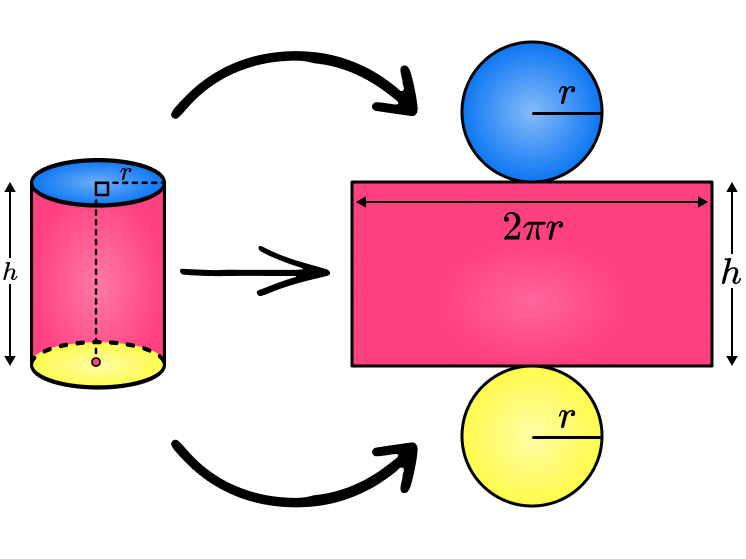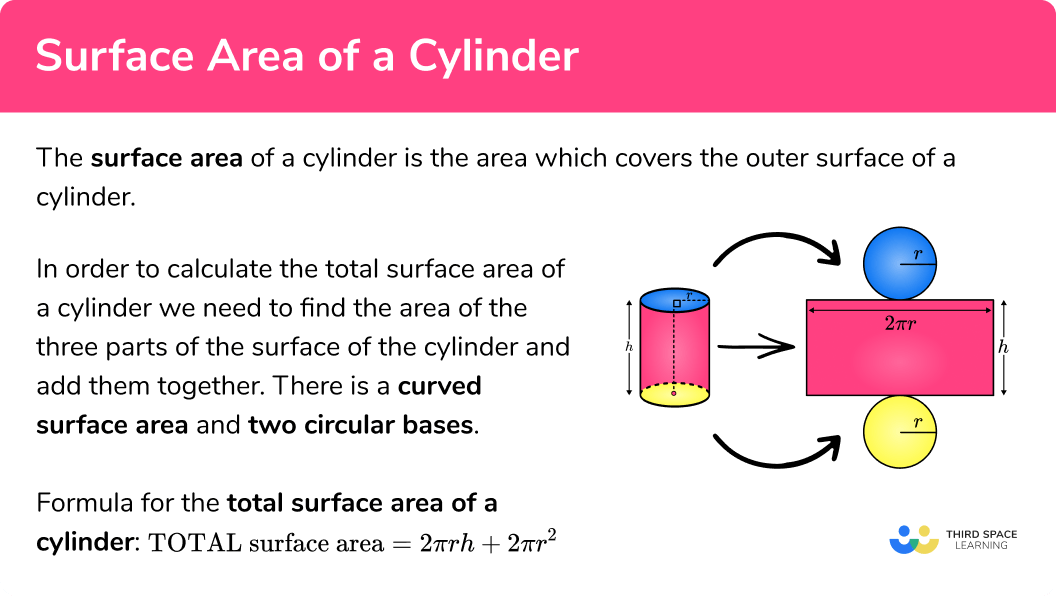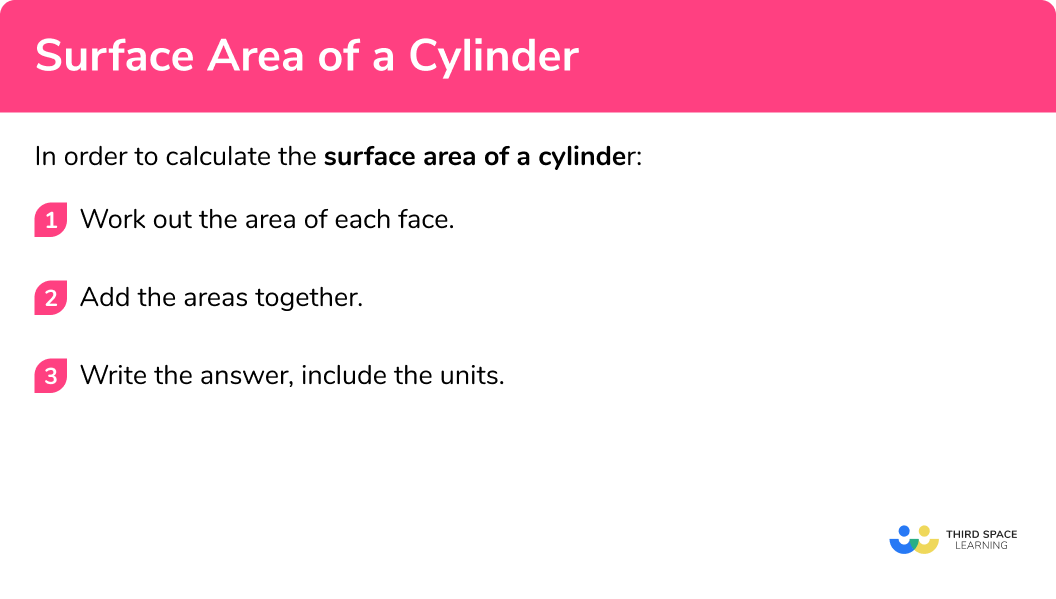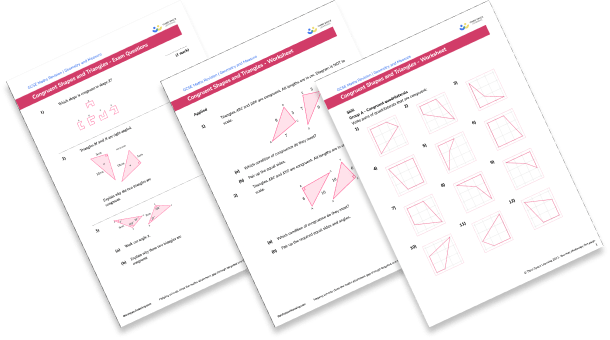One to one maths interventions built for KS4 success
Weekly online one to one GCSE maths revision lessons now available
In order to access this I need to be confident with:
Substitution How to work out perimeter Areas of circles Area of compound shapes Maths formulas Area of quadrilaterals Rounding numbersThis topic is relevant for:

Surface Area Of A Cylinder
Here we will learn about the surface area of a cylinder, including how to calculate the curved surface area of a cylinder given its radius and its perpendicular height. We will also look at calculating the total surface area of a cone.
There are also cylinder worksheets based on Edexcel, AQA and OCR exam questions, along with further guidance on where to go next if you’re still stuck.
What is the surface area of a cylinder?
The surface area of a cylinder is the area which covers the outer surface of a cylinder.
In order to calculate the total surface area of a cylinder we need to find the area of the three parts of the surface of the cylinder and add them together.
There is a curved surface area and two circular bases (the curved surface area of a cylinder is sometimes referred to as the lateral surface area of a cylinder).

r is the radius of the cylinder and h is the perpendicular height of a cylinder.
The curved surface area of a cylinder is actually a rectangle.
The circumference of the circle is the length of the rectangle.
The height h of the cylinder is the height of the rectangle.
\begin{aligned} \text{total surface area}&=2\pi rh+\pi r^2+ \pi r^2\\\\ &=2\pi rh+2\pi r^2 \end{aligned}To work out the formula for the surface area of a cylinder we need to work out the curved surface area and the area of the two circular bases
The curved surface area of a cylinder is a rectangular shape. The base of the rectangle is the circumference of the circle:
\text{Circumference of a circle}=\pi d=2\pi rThe height of the rectangle is height of the cylinder given by h.
To find the area of a rectangle we need to multiply the base 2\pi r by the height h, this gives us:
Formula for the curved surface area:
\text{Curved surface area}=2\pi rhThen we need to calculate the area of the base of the cylinder, this is a circle.
Formula for the area of circle:
The area of the top and the area of the base of a cylinder are the same.
So to find the the total surface area, we can add the curved surface area to the area of the two circles;
\begin{aligned} \text{total surface area}&=2\pi rh+\pi r^2+ \pi r^2\\\\ &=2\pi rh+2\pi r^2 \end{aligned}E.g.
Find the total surface area of this cylinder with radius of the base 7 cm and perpendicular height 10 cm.
First, we need to find the curved surface area of the cylinder:
\text{Curved surface area}=2\pi rh=2\times \pi \times 7 \times 10=140\piWe then need to find the area of the base of the cylinder:
\text{Area of a circle}=\pi r^2=\pi \times 7^2=49\piThe area of the top of the cylinder is the same as the area of the base so,
Total surface area:
140 \pi+49 \pi+49 \pi=238 \pi=747.699905 \ldotsSince the measurements of the cylinder are in cm, the surface area will be measured in cm^2.
The surface area of the cylinder is 747.7 \; cm^2 \; (1dp)
What is the surface area of a cylinder?

How to calculate the surface area of a cylinder
In order to calculate the surface area of a cylinder:
- Work out the area of each face.
- Add the areas together.
- Write the answer, including the units.
How to calculate the surface area of a cylinder


Surface area of a cylinder worksheet

Get your free surface area of a cylinder worksheet of 20+ questions and answers. Includes reasoning and applied questions.
DOWNLOAD FREE
Surface area of a cylinder worksheet

Get your free surface area of a cylinder worksheet of 20+ questions and answers. Includes reasoning and applied questions.
DOWNLOAD FREESurface area of a cylinder examples
Example 1: curved surface area
Find the curved surface area of the cylinder below, with radius 3 \; cm and perpendicular height 8 \; cm.
Give your answer to 1 decimal place.
- Work out the area of each face.
This question is only asking us for the curved surface area so we only need to find the area of one face.
\begin{aligned} \text{Curved surface area}&=2\pi rh\\\\ &=2 \times \pi \times 3 \times 8\\\\ &=150.7964474… \end{aligned}2Add the areas together.
Since we are only finding the curved surface area, we do not need to add any other areas.
3Write the answer, including the units.
We need to round the answer to 1 decimal place and include the units.
The curved surface area of the cylinder is: 150.8 \; cm^2 (to 1 dp )
Example 2: curved surface area – in terms of π
Find the curved surface area of the cylinder below, with radius 5 \; cm and perpendicular height 8 \;cm.
Leave your answer in terms of \pi .
Work out the area of each face.
This question is only asking us for the curved surface area so we only need to find the area of one face.
Add the areas together.
Since we are only finding the curved surface area, we do not need to add any other areas.
Write the answer, including the units.
We need to leave the answer in terms of \pi and include the units.
\text{Curved surface area }=80 \pi \mathrm{cm}^{2}
Example 3: total surface area
Find the total surface area of the cylinder below, with radius 4 \; cm and perpendicular height 9 \;cm.
Give your answer to 3 significant figures.
Work out the area of each face.
This question is asking us for the total surface area of the cylinder. We need to find the area of each face and add them together.
The area of the base is
\pi \times 4^{2}=50.2654...
The top face is the same as the bottom face so the area of the top is also 50.2654...
Add the areas together.
The sum of the areas is 226.1946+50.2654+50.2654 = 326.7254
Write the answer, including the units.
We need to round to 3 significant figures and include units.
The total surface area of the cylinder is: 327 \; cm^2 (to \; 3 sf)
Example 4: total surface area
Find the total surface area of the cylinder below, with radius 3.5 \; cm and perpendicular height 9.4 \;cm.
Give your answer to 3 significant figures.
Work out the area of each face.
This question is asking us for the total surface area of the cylinder. We need to find the area of each face and add them together.
\begin{aligned}\\ \text{Area of base }&= \pi r^{2}\\\\ &=\pi \times 3.5^{2}\\\\ &=38.4845 \end{aligned}
Area of top: 38.4845
Add the areas together.
The sum of the areas is 206.7167+38.4845+38.4845=283.6857
Write the answer, including the units.
We need to round to 3 significant figures and include units
The total surface area of the cylinder is 284 \; cm^2 (to \; 3 sf)
Example 5: total surface area
Find the total surface area of the cylinder below, with radius 6 \; cm and perpendicular height 8 \;cm.
Leave your answer in terms of \pi .
Work out the area of each face.
This question is asking us for the answer in terms of \pi . When calculating the area of each face we need to leave the answers in terms of \pi .
\begin{aligned} \\ \text{Area of base }&= \pi r^{2}\\\\ &=\pi \times 6^{2}\\\\ &=36 \pi \end{aligned}
Area of top: 36 \pi
Add the areas together.
Write the answer, including the units.
We need to leave the answer in terms of \pi and include the units.
The total surface area of the cylinder is:
168 \pi \; \mathrm{cm}^{2}
Example 6: total surface area
Find the total surface area of the cylinder below, with radius 2.7 \; cm and perpendicular height 6.3 \;cm.
Leave your answer in terms of \pi .
Work out the area of each face.
This question is asking us for the answer in terms of \pi . When calculating the area of each face we need to leave the answers in terms of \pi .
\begin{aligned} \\ \text{Area of base }&= \pi r^{2}\\\\ &=\pi \times 2.7^{2}\\\\ &=7.29 \pi \end{aligned}
Area of top: 7.29 \pi
Add the areas together.
Write the answer, including the units.
We need to leave the answer in terms of \pi and include the units.
The total surface area of the cylinder is:
48.6 \pi \; \mathrm{cm}^{2}
Common misconceptions
- Rounding
It is important to not round the answer until the end of the calculation. This will mean your final answer is accurate.
- Using the radius or the diameter
It is a common error to mix up radius and diameter. Remember the radius is half of the diameter and the diameter is double the radius.
- Correct units
For area we use square units such as cm^2.
For volume we use cube units such as cm^3.
- Check what you have answered the question
Double check if you are asked to just find the curved surface area or the total surface area.
Related lessons
Surface area of a cylinder is part of our series of lessons to support revision on cylinders. You may find it helpful to start with the main cylinder lesson for a summary of what to expect, or use the step by step guides below for further detail on individual topics. Other lessons in this series include:
Practice surface area of a cylinder questions
1. Find the curved surface area of a cylinder of radius 5.2 \; cm and perpendicular height 8.3 \; cm .
Give your answer to 3 significant figures.




We are finding the curved surface area of a cylinder so we substitute the value of
r and h into the formula.
\begin{aligned} \text{Curved surface area}&=2\pi rh\\\\ &=2 \times \pi \times 5.2\times 8.3\\\\ &=271.182…\\\\ &=271 \ cm^2 \ \text{(to 3 sf)} \end{aligned}
2. Find the curved surface area of a cylinder of radius 6.7 \; cm and perpendicular height 4.9 \; cm .
Give your answer to 3 significant figures.




We are finding the curved surface area of a cylinder so we substitute the value of
r and h into the formula.
\begin{aligned} \text{Curved surface area}&=2\pi rh\\\\ &=2 \times \pi \times 6.7\times 4.9\\\\ &=206.27…\\\\ &=206 \ cm^2 \ \text{(to 3 sf)} \end{aligned}
3. Find the curved surface area of a cylinder of radius 2\; cm and perpendicular height 7 \; cm .
Leave your answer to in terms of \pi .




We are finding the curved surface area of a cylinder so we substitute the value of
r and h into the formula.
\begin{aligned} \text{Curved surface area}&=2\pi rh\\\\ &=2 \times \pi \times 2\times 7\\\\ &=28\pi\\\\ &=28\pi \ cm^2 \end{aligned}
4. Find the total surface area of a cylinder of radius 6.1\; cm and perpendicular height 3.9 \; cm .
Give your answer to 3 significant figures.




We are finding the total surface area of a cylinder so we find the area of each face and add them together.
\begin{aligned} \text{Curved surface area}&=2\pi rh\\\\ &=2 \times \pi \times 6.1\times 3.9\\\\ &=149.4769… \end{aligned}
\begin{aligned} \\ \text{Area of circle }&=\pi r^2\\\\ &=\pi \times 6.1^2\\\\ &=116.8986… \end{aligned}
Total surface area: 149.4769+116.8986+116.8986=383.2741
Surface area = 383 \; cm^2 \; (3sf)
5. Find the total surface area of a cylinder of radius 2.7\; cm and perpendicular height 8.6 \; cm .
Give your answer to 3 significant figures.




We are finding the total surface area of a cylinder so we find the area of each face and add them together.
\begin{aligned} \text{Curved surface area}&=2\pi rh\\ &=2 \times \pi \times 2.7\times 8.6\\ &=145.8955… \end{aligned}
\begin{aligned} \\ \text{Area of circle }&=\pi r^2\\ &=\pi \times 2.7^2\\ &=22.9022… \end{aligned}
Total surface area: 145.8955+22.9022+22.9022=191.6999
Surface area = 192 \; cm^2 \; (3sf)
6. Find the total surface area of a cylinder of radius 2\; cm and perpendicular height 6 \; cm .
Leave your answer to in terms of \pi .




We are finding the total surface area of a cylinder so we find the area of each face and add them together
\begin{aligned} \text{Curved surface area}&=2\pi rh\\ &=2 \times \pi \times 2\times 6\\ &=24\pi \end{aligned}
\begin{aligned} \\ \text{Area of circle }&=\pi r^2\\ &=\pi \times 2^2\\ &=4 \pi \end{aligned}
Total surface area: 24\pi + 4 \pi + 4 \pi = 32\pi \mathrm{cm}^{2}
Surface area of a cylinder GCSE questions
1. Here is a cylinder.
Calculate the total surface area of the cylinder.
Give your answer to 3 significant figures.
(3 marks)
(1)
137.790… + 2\times \pi \times 5.1^2=137.790…+163.425…
(1)
301.21…=301
(1)
2. Here is a cylinder.
Calculate the total surface area of the cylinder.
Leave your answer in terms of \pi .
(3 marks)
(1)
42\pi + 2\times \pi \times 3^2=42\pi+18\pi
(1)
60\pi
(1)
3. Sarah has to cover 4 containers completely with paint.
Each container is the shape of a cylinder with a top and a bottom.
The container had a radius of 0.7 \; m and a height of 1.3\; m.
Sarah has 8 tins of paint.
Each tin of paint covers 4 \; m^2 .
Does Sarah have enough paint to cover the containers?
You must show how you get your answer.
(5 marks)
\pi \times 0.7^2=1.5393…
For finding the area of a circle
(1)
2\times \pi \times 0.7 \times 1.3=5.7176
For finding the curved surface area of a cylinder
(1)
4\times(5.7176…+2\times 1.5393…)=35.18…
For finding the Ttotal surface area of 4 cylinders
(1)
8\times 4=32
For finding the coverage of the tins
(1)
No, because 32 is less than 35.18…
For the final answer with supporting workings
(1)
Learning checklist
You have now learned how to:
- Work out the volume of a cylinder
- Solve problems involving the volume of a cylinder
The next lessons are
Beyond GCSE
For GCSE we look at right circular cylinders – where the bases are parallel planes and the height is perpendicular to these bases. It is possible to have oblique cylinders.
It is also possible to have a cylinder with an ellipse as its base.
Still stuck?
Prepare your KS4 students for maths GCSEs success with Third Space Learning. Weekly online one to one GCSE maths revision lessons delivered by expert maths tutors.

Find out more about our GCSE maths tuition programme.